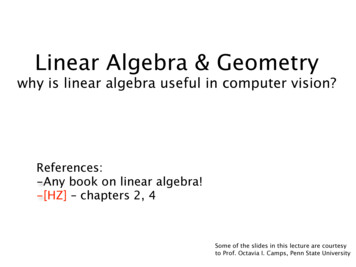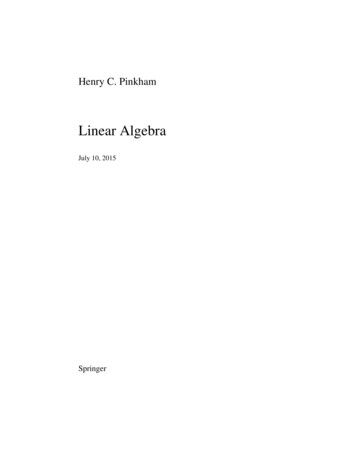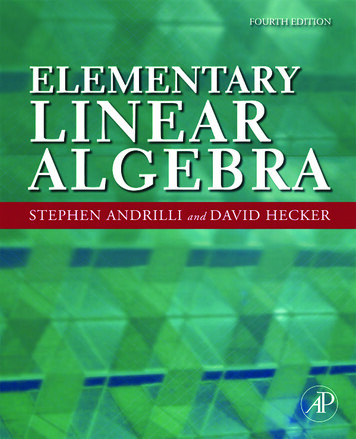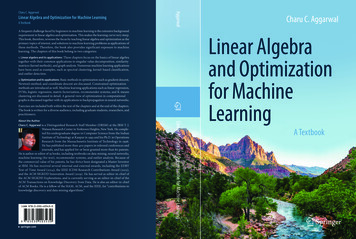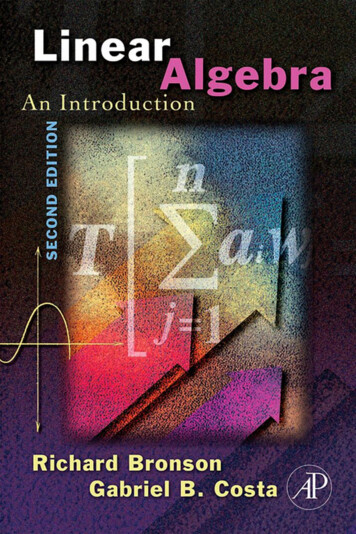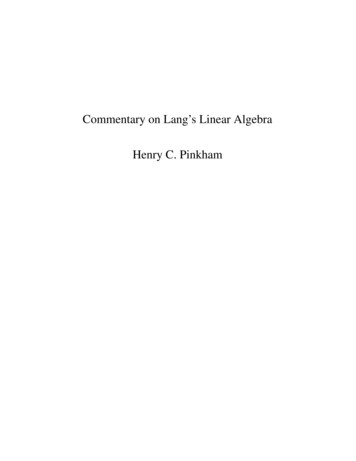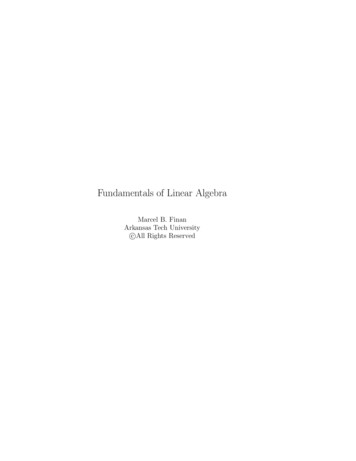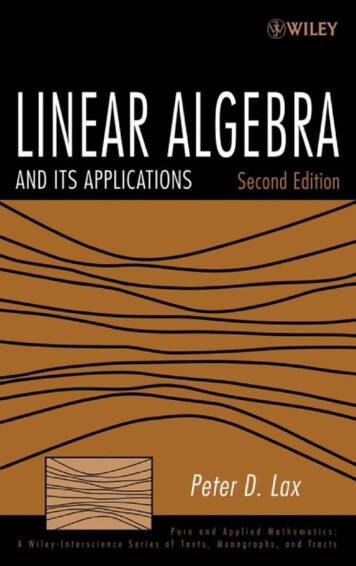
Transcription
(FW I LEYLINEAR ALGEBRAAND ITS APPLICATIONSSecond EditionaimPure and Applied Morhemotics:A Wiley-laterscienca Series of Texts, Monographs, and Tracts
Linear Algebra and ItsApplications
.1807i;:,1 9WILEY!zw2007'ererrfiti.hTHE WILEY BICENTENNIAL-KNOWLEDGE FOR GENERATIONS(S ach generation has its unique needs and aspirations. When Charles Wiley firstopened his small printing shop in lower Manhattan in 1807. it was a generationof boundless potential searching for an identity. And we were there, helping todefine a new American literary tradition. Over half a century later, in the midstof the Second Industrial Revolution, it was a generation focused on building thefuture. Once again, we were there, supplying the critical scientific, technical, andengineering knowledge that helped frame the world. Throughout the 20thCentury, and into the new millennium, nations began to reach out beyond theirown borders and a new international community was born. Wiley was there,expanding its operations around the world to enable a global exchange of ideas,opinions, and know-how.For 200 years, Wiley has been an integral part of each generation's journey,enabling the flow of information and understanding necessary to meet their needsand fulfill their aspirations. Today, bold new technologies are changing the waywe live and learn. Wiley will be there, providing you the must-have knowledgeyou need to imagine new worlds, new possibilities, and new opportunities.Generations come and go, but you can always count on Wiley to provide you theknowledge you need, when and where you need it!WILLIAM J. PESCEPETER BOOTH WILEYPRESIDENT AND CHIEF EXECLmvE OFFICERCHAIRMAN OF THE BOARD
Linear Algebra and ItsApplicationsSecond EditionPETER D. LAXNew York UniversityCourant Institute of Mathematical SciencesNew York, NYIe[Nr[N N SAL1 8 0 7"*WILEY2007 !ale [Nv [NN111 LCWILEY-LNTER.SCIENCEA JOHN WILEY & SONS, INC., PUBLICATION
Copyright Cl 2007 by John Wiley & Sons, Inc., Hoboken, New Jersey. All rights reserved.Published simultaneously in Canada.No pan of this publication may be reproduced, stored in a retrieval system or transmitted in any form orby any means, electronic, mechanical, photocopying, recording, scanning or otherwise, except aspermitted under Sections 107 or 108 of the 1976 United States Copyright Act, without either theprior written permission of the Publisher, or authorization through payment of the appropriatepercopy fee to the Copyright Clearance Center, 222 Rosewood Drive, Danvers, MA 01923,(978) 750-8400, fax (978) 750.4744. Requests to the Publisher for permission should be addressedto the Permissions Department, John Wiley & Sons, Inc., 605 Third Avenue, New York, NY 10158-0012,(212) 850-6011, fax (212) 850-6008, E-Mail: PERMREQ CO WILEY.COM.For ordering and customer service, call 1-800-CALL-WILEY.Wiley Bicentennial Logo: Richard J. PacificoLibrary of Congress Cataloging-in-Publication Data:Lax, Peter D.Linear algebra and its applications / Peter D. Lax. - 2nd ed.p. cm. - (Pure and applied mathematics. A Wiley-Interscience of texts, monographs and tracts)Previous ed.: Linear algebra. New York : Wiley, c1997.Includes bibliographical references and index.ISBN 978-0-471-75156-4 (cloth)1.Algebras, Linear.1. Lax, Peter D. Linear algebra. 11. Title.QAI84.2.L38 2008512'.5-dc222007023226Printed in the United States of America1098765432I
ContentsPrefacePreface to the First Fditinn1.FundamentalsLinear Space, IsomorphismSubspaceLinear DependenceBasis, DimensionQuotient Space2.3.DualityLinear FunctionsDual of a Linear SpaceAnnihilatorCodimensionQuadrature Formula131314L17Linear MappingsDomain and Target SpaceNullspace and RangeFundamental TheoremUnderdetermined Linear SystemsInterpolationDifference EquationsAlgebra of Linear MappingsDimension of Nullspace and ows and ColumnsMatrix Multiplicationv
CONTENTSviTranspositionRankGaussian Elimination5. Determinant and TraceOrdered SimplicesSigned Volume. DeterminantPermutation GroupFormula for DeterminantMultiplicative PropertyLaplace ExpansionC'ramer'c RuleTrace6. Spectral TheoryIteration of Linear MapsEigenvalues. EigenvectorsFihonacci SequenceCharacteristic PolynomialTrace and Determinant RevisitedSpectral Mapping TheoremCayley-Hamilton TheoremGeneralized EigenvcctorsSpectral TheoremMinimal PolynomialWhen Are Two Matrices SimilarCommuting Maps7-Euclidean StructureScalar Product. DistanceSchwarg InequalityOnhonormal BasisGram-SchmidtOrthogonal ComplementOrthogonal ProjectionAdjoinsOverdetermined SystemsIsometryThe Orthogonal GroupNorm of a Linear MapCompleteness Local CompactnessComplex Euclidean StructureSpectral RadiusHilhert-Schmidt NormCross Product
CONTENTS8.Spectral Theory of Self-Adioint MappingsQuadratic FormsLaw of InertiaSpectral ResolutionCommuting MapsAnti-Self-Adjoint MapsNormal MapsRayleigh QuotientMinmax PrincipleNorm and Eigenvalues9.Calculus of Vector- and Matrix-Valued FunctionsConvergence in NormRules of DifferentiationDerivative of det A(r)Matrix ExponentialSimple Eigenvaluesvii101102An105111112112114116119m1211 11126128129Multiple Eigenvalues135Rellich's Theorem144Avoidance of Crossing14010. Matrix Inequalities143Positive Self-Adjoint Matrices143Monotone Matrix Functions1.5.1Gram Matrices1.52Schur's Theorem1.5.3The Determinant of Positive Matrices154Integral Formula for Determinants157Eigenvalues16()Separation of Eigenvalues161Wielandt-Hoffman TheoremSmallest and Largest Eigenvalue1AMatrices with Positive Se]f-Adjoint Part167Polar DecompositionSingular ValuesSingular Value Decomposition17016616917011. Kinematics and Dynamics172Axis and Angle of RotationRigid MotionAngular Velocity VectorFluid Flow172Curl and DivergenceSmall VibrationsConservation of EnergyFrequencies and Normal Modes17917317612ian182184
viiiCONTENTS12. Convexity187Convex Sets187Gauge FunctionHahn-Banach TheoremSupport FunctionCaratheodorv's TheoremKonig-Birkhoff TheoremHelly's Theorem18813. The Duality TheoremFarkas Minkowski TheoremDuality TheoremEconomics InterpretationMinmax Theorem14. Normed Linear Spaces1911931951981992022032062082151Norm214214h Nouns215Equivalence of NormsCompletenessLocal CompactnessTheorem of F. RicszDual NormDistance from SubspaceNormed Quotient SpaceComplex Normed SpacesComplex Hahn-Banach TheoremCharacterization of Euclidean Spaces21715. Linear Mappings Between Normed Linear SpacesNorm of a MappingNorm of TransposeNormed Algebra of ble Maps233Spectral Radius23616. Positive MatricesPerron's Theorem237237Stochastic Matrices240Frohenius' Theorem24317. How to Solve Systems of Linear EquationsHistoryCondition NumberIterative MethodsSteepest DescentChebychev Iteration246246241E24.8.249252
CONTENTSixThree-term Chebychev Iteration255Optimal Three-Teen Recursion RelationRate of Convergence25626118. How to Calculate the Eigenvalues of Seif-Adjoint Matrices262QR FactorizationUsing the QR Factorization to Solve Systems of EquationsThe QR Algorithm for Finding EigenvaluesHouseholder Reflection for OR FactorizationTridiagonal ForniAnalogy of QR Algorithm and Toda FlowMneer'x Theorem262263More General Flows26326626726922327619. Solutions218Bibliography300Appendix 1. Special Determinants302Appendix 2. The Pfaffian305Appendix 3. Symplectic Matrices308Appendix 4. Tensor Product313Appendix 5. Lattices317Appendix 6. Fast Matrix Multiplication320Appendix 7. Gershgorin's Theorem323Appendix 8. The Multiplicity of Eigenvalues325Appendix 9. The Fast Fourier Transform328Appendix 10. The Spectral Radius334Appendix 11. The Lorentz Group342Appendix 12. Compactness of the Unit Ball352Appendix 13. A Characterization of Commutators355Appendix 14. Liapunov's Theorem357Appendix 15. The Jordan Canonical Form363Appendix 16. Numerical Range367Index,373
PrefaceThe outlook of this second edition is the same as that of the original: to present linearalgebra as the theory and practice of linear spaces and linear mappings. Where it aidsunderstanding and calculations, I don't hesitate to describe vectors as arrays ofnumbers and to describe mappings as matrices. Render onto Caesar the things whichare Caesar's.If you can reduce a mathematical problem to a problem in linear algebra, you canmost likely solve it, provided that you know enough linear algebra. Therefore, athorough grounding in linear algebra is highly desirable. A sound undergraduateeducation should offer a second course on the subject, at the senior level. I wrote thisbook as a suitable text for such a course. The changes made in this second edition arepartly to make it more suitable as a text. Terse descriptions, especially in the earlychapters, were expanded, more problems were added, and a list of solutions toselected problems has been provided.In addition, quite a bit of new material has been added, such as the compactnessof the unit ball as a criterion of finite dimensionality of a normed linear space. A newchapter discusses the QR algorithm for finding the eigenvalues of a self-adjointmatrix. The Householder algorithm for turning such matrices into tridiagonal form ispresented. I describe in some detail the beautiful observation of Deift, Nanda, andTomei of the analogy between the convergence of the QR algorithm and Moser'stheorem on the asymptotic behavior of the Toda flow as time tends to infinity.Eight new appendices have been added to the first edition's original eight,including the Fast Fourier Transform, the spectral radius theorem, proved with thehelp of the Schur factorization of matrices, and an excursion into the theory ofmatrix-valued analytic functions. Appendix 11 describes the Lorentz group, 12 is aninteresting application of the compactness criterion for finite dimensionality, 13 is acharacterization of commutators, 14 presents a proof of Liapunov's stabilitycriterion, 15 presents the construction of the Jordan Canonical form of matrices, and16 describes Carl Pearcy's elegant proof of Halmos' conjecture about the numericalrange of matrices.I conclude with a plea to include the simplest aspects of linear algebra in high-school teaching: vectors with two and three components, the scalar product, thexi
XiiPREFACEcross product, the description of rotations by matrices, and applications to geometry.Such modernization of the high-school curriculum is long overdue.I acknowledge with pleasure much help I have received from Ray Michalek, aswell as useful conversations with Albert Novikoff and Charlie Peskin. I also wouldlike to thank Roger Horn, Beresford Parlett, and Jerry Kazdan for very usefulcomments, and Jeffrey Ryan for help in proofreading.PETER D. LAXNew York. New York
Preface to the First EditionThis book is based on a lecture course designed for entering graduate students andgiven over a number of years at the Courant Institute of New York University. Thecourse is open also to qualified undergraduates and on occasion was attended bytalented high school students, among them Alan Edelman; I am proud to have beenthe first to teach him linear algebra. But, apart from special cases, the book, like thecourse, is for an audience that has some-not much-familiarity with linear algebra.Fifty years ago, linear algebra was on its way out as a subject for research. Yetduring the past five decades there has been an unprecedented outburst of new ideasabout how to solve linear equations, carry out least square procedures, tacklesystems of linear inequalities, and find eigenvalues of matrices. This outburst camein response to the opportunity created by the availability of ever faster computerswith ever larger memories. Thus, linear algebra was thrust center stage in numericalmathematics. This had a profound effect, partly good, partly bad, on how the subjectis taught today.The presentation of new numerical methods brought fresh and exciting material,as well as realistic new applications, to the classroom. Many students, after all, are ina linear algebra class only for the applications. On the other hand, bringingapplications and algorithms to the foreground has obscured the structure of linearalgebra-a trend I deplore; it does students a great disservice to exclude them fromthe paradise created by Emmy Noether and Emil Artin. One of the aims of this bookis to redress this imbalance.My second aim in writing this book is to present a rich selection of analyticalresults and some of their applications: matrix inequalities, estimates for eigenvaluesand determinants, and so on. This beautiful aspect of linera algebra, so useful forworking analysts and physicists, is often neglected in texts.I strove to choose proofs that are revealing, elegant, and short. When there aretwo different ways of viewing a problem, I like to present both.The Contents describes what is in the book. Here I would like to explain mychoice of materials and their treatment. The first four chapters describe the abstracttheory of linear spaces and linear transformations. In the proofs I avoid eliminationof the unknowns one by one, but use the linear structure; I particularly exploitxiii
AVPREFACE TO THE FIRST EDITIONquotient spaces as a counting device. This dry material is enlivened by somenontrivial applications to quadrature, to interpolation by polynomials, and to solvingthe Dirichlet problem for the discretized Laplace equation.In Chapter 5, determinants are motivated geometrically as signed volumes ofordered simplices. The basic algebraic properties of determinants follow immediately.Chapter 6 is devoted to the spectral theory of arbitrary square matrices withcomplex entries. The completeness of eigenvectors and generalized eigenvectors isproved without the characteristic equation, relying only on the divisibility theory ofthe algebra of polynomials. In the same spirit we show that two matrices A and B aresimilar if and only if (A - kI)t and (B - kl)"' have nullspaces of the samedimension for all complex k and all positive integer in. The proof of this propositionleads to the Jordan canonical form.Euclidean structure appears for the first time in Chapter 7. It is used in Chapter 8to derive the spectral theory of selfadjoint matrices. We present two proofs, onebased on the spectral theory of general matrices, the other using the variationalcharacterization of eigenvectors and eigenvalues. Fischer's minmax theorem isexplained.Chapter 9 deals with the calculus of vector- and matrix-valued functions of asingle variable, an important topic not usually discussed in the undergraduatecurriculum. The most important result is the continuous and differentiable characterof eigenvalues and normalized eigenvectors of differentiable matrix functions,provided that appropriate nondegeneracy conditions are satisfied. The fascinatingphenomenon of "avoided crossings" is briefly described and explained.The first nine chapters, or certainly the first eight, constitute the core of linear algebra.The next eight chapters deal with special topics, to be taken up depending on the interestof the instructor and of the students. We shall comment on them very briefly.Chapter 10 is a symphony of inequalities about matrices, their eigenvalues, andtheir determinants. Many of the proofs make use of calculus.I included Chapter 11 to make up for the unfortunate disappearance of mechanicsfrom the curriculum and to show how matrices give an elegant description of motionin space. Angular velocity of a rigid body and divergence and curl of a vector field allappear naturally. The monotonic dependence of eigenvalues of symmetric matricesis used to show that the natural frequencies of a vibrating system increase if thesystem is stiffened and the masses are decreased.Chapters 12, 13, and 14 are linked together by the notion of convexity. In Chapter12 we present the descriptions of convex sets in terms of gauge functions and supportfunctions. The workhorse of the subject, the hyperplane separation theorem, isproved by means of the Hahn-Banach procedure. Carathdodory's theorem onextreme points is proved and used to derive the Konig-Birkhoff theorem on doublystochastic matrices; Helly's theorem on the intersection of convex sets is stated andproved.Chapter 13 is on linear inequalities; the Farkas-Minkowski theorem is derivedand used to prove the duality theorem, which then is applied in the usual fashion to amaximum-minimum problem in economics, and to the minmax theorem of vonNeumann about two-person zero-sum games.
PREFACE TO THE FIRST EDITIONXVChapter 14 is on normed linear spaces; it is mostly standard fare except for a dualcharacterization of the distance of a point from a linear subspace. Linear mappingsof normed linear spaces are discussed in Chapter 15.Chapter 16 presents Perron's beautiful theorem on matrices all of whose entriesare positive. The standard application to the asymptotics of Markov chains isdescribed. In conclusion, the theorem of Frobenius about the eigenvalues of matriceswith nonnegative entries is stated and proved.The last chapter discusses various strategies for solving iteratively systems oflinear equations of the form Ax b, A a self-adjoint, positive matrix. A variationalformula is derived and a steepest descent method is analyzed. We go on to presentseveral versions of iterations employing Chebyshev polynomials. Finally wedescribe the conjugate gradient method in terms of orthogonal polynomials.It is with genuine regret that I omit a chapter on the numerical calculation ofeigenvalues of self-adjoint matrices. Astonishing connections have been discoveredrecently between this important subject and other seemingly unrelated topics.Eight appendices describe material that does not quite fit into the flow of the text,but that is so striking or so important that it is worth bringing to the attention ofstudents. The topics I have chosen are special determinants that can be evaluatedexplicity, Pfaff's theorem, symplectic matrices, tensor product, lattices, Strassen'salgorithm for fast matrix multiplication, Gershgorin's theorem, and the multiplicityof eigenvalues. There are other equally attractive topics that could have been chosen:the Baker-Campbell-Hausdorff formula, the Kreiss matrix theorem, numericalrange, and the inversion of tridiagonal matrices.Exercises are sprinkled throughout the text; a few of them are routine; mostrequire some thinking and a few of them require some computing.My notation is neoclassical. I prefer to use four-letter Anglo-Saxon words like"into," "onto" and "1-to-1," rather than polysyllabic ones of Norman origin. Theend of a proof is marked by an open square.The bibliography consists of the usual suspects and some recent texts; in addition,I have included Courant-Hilbert, Volume I, unchanged from the original Germanversion in 1924. Several generations of mathematicians and physicists, including theauthor, first learned linear algebra from Chapter 1 of this source.I am grateful to my colleagues at the Courant Institute and to Myron Allen at theUniversity of Wyoming for reading and commenting on the manuscript and fortrying out parts of it on their classes. I am grateful to Connie Engle and Janice Wantfor their expert typing.Ihave learned a great deal from Richard Bellman's outstanding book,Introduction to Matrix Analysis; its influence on the present volume is considerable.For this reason and to mark a friendship that began in 1945 and lasted until his deathin 1984, I dedicate this book to his memory.PETER D. LAXNew York, New York
CHAPTER IFundamentalsThis first chapter aims to introduce the notion of an abstract linear space to thosewho think of vectors as arrays of components. I want to point out that the class ofabstract linear spaces is no larger than the class of spaces whose elements are arrays.So what is gained by this abstraction?First of all, the freedom to use a single symbol for an array; this way we can thinkof vectors as basic building blocks, unencumbered by components. The abstractview leads to simple, transparent proofs of results.More to the point, the elements of many interesting vector spaces are notpresented in terms of components. For instance, take a linear ordinary differentialequation of degree n; the set of its solutions form a vector space of dimension n, yetthey are not presented as arrays.Even if the elements of a vector space are presented as arrays of numbers, theelements of a subspace of it may not have a natural description as arrays. Take, forinstance, the subspace of all vectors whose components add up to zero.Last but not least, the abstract view of vector spaces is indispensable for infinitedimensional spaces; even though this text is strictly about finite-dimensional spaces,it is a good preparation for functional analysis.Linear algebra abstracts the two basic operations with vectors: the addition ofvectors, and their multiplication by numbers (scalars). It is astonishing that on suchslender foundations an elaborate structure can be built, with romanesque, gothic, andbaroque aspects. It is even more astounding that linear algebra has not only the righttheorems but also the right language for many mathematical topics, includingapplications of mathematics.A linear space X over afield K is a mathematical object in which two operationsare defined:Addition, denoted by , as in(1)Linear Algebra and Its Applications. Second Edition, by Peter D. LaxCopyright '! 2007 John Wiley & Sons, Inc.1
2LINEAR ALGEBRA AND ITS APPLICATIONSand assumed to be commutative:x y y x,(2)x (y z) (x y) z,(3)and associative:and to form a group, with the neutral element denoted as 0:x 0 x.(4)The inverse of addition is denoted by -:x (-x) - x - x 0.EXERCISE I.(5)Show that the zero of vector addition is unique.The second operation is multiplication of elements of X by elements k of thefield K:kx.The result of this multiplication is a vector, that is, an element of X.Multiplication by elements of K is assumed to be associative:k(ax) (ka)x(6)k(x y) kx ky,(7)(a b)x ax bx.(8)and distributive:as well asWe assume that multiplication by the unit of K, denoted as 1, acts as the identity:(9)These are the axioms of linear algebra. We proceed to draw some deductions:Set b 0 in (8); it follows from Exercise 1 that for all xOx 0.(10)
FUNDAMENTALS3Set a 1, b -1 in (8); using (9) and (10) we deduce that for all x(-1)x -x.EXERCISE 2. Show that the vector with all components zero serves as the zeroelement of classical vector addition.In this analytically oriented text the field K will be either the field Fl of realnumbers or the field C of complex numbers.An interesting example of a linear space is the set of all functions x(t) that satisfythe differential equationd2dt2x x 0.The sum of two solutions is again a solution, and so is the constant multiple of one.This shows that the set of solutions of this differential equation form a linear space.Solutions of this equation describe the motion of a mass connected to a fixedpoint by a spring. Once the initial position x(0) p and initial velocity drx(0) vare given, the motion is completely determined for all t. So solutions can bedescribed by a pair of numbers (p, v).The relation between the two descriptions is linear; that is, if (p, v) are the initialdata of a solution x(t), and (q, w) the initial data of another solution y(t), then theinitial data of the solution x(t) y(t) are (p q, v w) (p, v) (q, w). Similarly,the initial data of the solution kx(t) are (kp, kv) k(p, v).This kind of relation has been abstracted into the notion of isomorphism.Definition. A one-to-one correspondence between two linear spaces over thesame field that maps sums into sums and scalar multiples into scalar multiples iscalled an isomorphism.Isomorphism is a basic notion in linear algebra. Isomorphic linear spaces areindistinguishable by means of operations available in linear spaces. Two linearspaces that are presented in very different ways can be, as we have seen, isomorphic.E x a m p l e s o f Linear S p a c e s . (i) Set of all row vectors: (a, , . , an), aj in K;addition, multiplication defined componentwise. This space is denoted as K".(ii) Set of all real-valued functions f(x) defined on the real line, K R.(iii) Set of all functions with values in K, defined on an arbitrary set S.(iv) Set of all polynomials of degree less than n with coefficients in K.EXERCISE 3.Show that (i) and (iv) are isomorphic.EXERCISE 4.Show that if S has n elements, (i) and (iii) are isomorphic.
4LINEAR ALGEBRA AND ITS APPLICATIONSEXERCISE 5.Show that when K 08, (iv) is isomorphic with (iii) when Sconsists of n distinct points of R.Definition. A subset Yof a linear space X is called a subspace if sums and scalarmultiples of elements of Y belong to Y.Examples of Subspaces. (a) X as in Example (i), Y the set of vectors(0,a2-.,a,,-I,0) whose first and last component is zero.(b) X as in Example (ii), Y the set of all periodic functions with period 7r.(c) X as in Example (iii), Y the set of constant functions on S.(d) X as in Example (iv), Y the set of all even polynomials.Definition. The sum of two subsets Y and Z of a linear space X, denoted asY Z, is the set of all vectors of form y z, y in Y, z in Z.EXERCISE 6.Prove that Y Z is a linear subspace of X if Y and Z are.Definition. The intersection of two subsets Yand Z of a linear space X, denotedas Y fl z, consists of all vectors x that belong to both Yand ZEXERCISE 7.Prove that if Yand Z are linear subspaces of X, so is Y fl Z.EXERCISE 8. Show that the set {0} consisting of the zero element of a linearspace X is a subspace of X. It is called the trivial subspace.Definition. A linear combination of j vectors x, , . x1 of a linear space is avector of the formkixlEXERCISE 9.k,,.,kJ E K.Show that the set of all linear combinations of x , , . , xj is asubspace of X, and that it is the smallest subspace of X containing x, , . , x1. This iscalled the subspace spanned by x, . , xJ.Definition. A set of vectors x, , . , x, in X span the whole space X if everyx inX can be expressed as a linear combination of x,, . ,x,,,.Definition. The vectors x,,.,xj are called linearly dependent if there is anontrivial linear relation between them, that is, a relation of the form 0,where not all k, , . , kJ are zero.
FUNDAMENTALSSDefinition. A set of vectors x1,. . , xj that are not linearly dependent is calledlinearly independent.EXERCISE 10. Show that if the vectors xi , . , xj are linearly independent, thennone of the x; is the zero vector.Lemma 1. Suppose that the vectors xi, . , x,, span a linear space X and that the. . , y, in X are linearly independent. Thenvectors y1, .j n.Proof. Since x1,.,x span X, every vector in X can be written as a linearcombination of xi,.,x,,. In particular, yi:y,Since yi # 0 (see Exercise 10), not all k are equal to 0, say k, # 0. Then xi can beexpressed as a linear combination of yi and the remaining x,. So the set consisting ofthe x's, with xi replaced by yj span X. If j n, repeat this step n - 1 more times andconclude that yi, . , y span X: if j n, this contradicts the linear independence ofthe y's f o r theny,. .Definition. A finite set of vectors which span X and are linearly independent iscalled a basis for X.Lemma 2. A linear space X which is spanned by a finite set of vectors x, . , xhas a basis.Proof If x1, . ,x are linearly dependent, there is a nontrivial relation betweenthem; from this one of the xi can be expressed as a linear combination of the rest. Sowe can drop that xi. Repeat this step until the remaining xj are linear independent:they still span X, and so they form a basis.Definition.A linear space X is called finite dimensional if it has a basis.A finite-dimensional space has many, many bases. When the elements of thespace are represented as arrays with n components, we give preference to the specialbasis consisting of the vectors that have one component equal to 1, while all theothers equal 0.Theorem 3. All bases for a finite-dimensional linear space X contain the samenumber of vectors. This number is called the dimension of X and is denoted asdim X.
6LINEAR ALGEBRA AND ITS APPLICATIONSProof. Let x,, . , x be one basis, and let yl, . , ybe another. By Lemma I andthe definition of basis we conclude that m n, and also n m. So we conclude thatn and m are equal.We define the dimension of the trivial space consisting of the single element 0 tobe zero.Theorem 4. Every linearly independent set of vectors y, , . , yj in a finitedimensional linear space X can be completed to a basis of X.Proof. If y, , . , }7 do not span X, there is some x, that cannot be expressed as alinear combination of y,. , y,. Adjoin this x, to the y's. Repeat this step until they's span X. This will happen in less than n steps, n dim X, because otherwise Xwould contain more than n linearly independent vectors, impossible for a space ofdimension n.Theorem 4 illustrates the many different ways of forming a basis for a linearspace.Theorem 5. (a) Every subspace Y of a finite-dimensional linear space X isfinite dimensional.(b) Every subspace Y has a complement in X, that is, another subspace Z suchthat every vector x in X can be decomposed uniquely asx y z,yinY,zinZ.(11)FurthermoredimX dim Y dim Z.(11)'Proof. We can construct a basis in Y by starting with any nonzero vector yl, andthen adding another vector Y2 and another, as long as they are linearly independent.According to Lemma 1, there can be no more of these yi than the dimension of X. Amaximal set of linearly independent vectors y,, . , yj in Y spans Y, and so forms abasis of Y According to Theorem 4, this set can be completed to form a basis of X byadjoining Zj , , . , Z,,. Define Z as the space spanned by Zj , , . , Z,,; clearly YandZ are complements, anddimX n j (n-j) dimY dimZ.Definition. X is said to be the direct sum of two subspaces Y and Z that arecomplements of each other. More
the first to teach him linear algebra. But, apart from special cases, the book, like the course, is for an audience that has some-not much-familiarity with linear algebra. Fifty years ago, linear algebra was on its way out as a subject for research. Yet during the past five decades there has been an unprecedented outburst of new ideas
